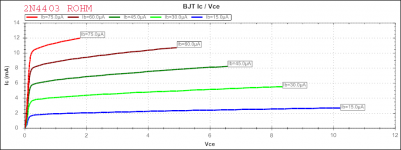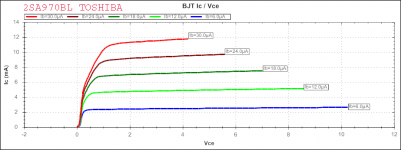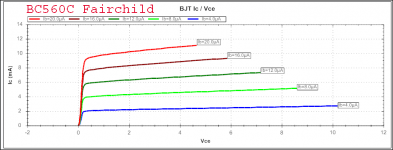Thx for explanation Salas ! I may just as well measure gain by injecting small signal and see what comes out ? and than make a second selection of the pairs , quads etc. ?? but I assume that gain may differ over frequency as well . 
THX Salas !
Paul

THX Salas !
Paul
It will only be valid in same circuit cell emulation as to be finally applied.
The full picture for a device would include measuring all DC parameters plus self noise sample selection and curve tracing. Too much for building stuff, nice for lab thoroughness.
IDSS matching and maybe Vp check should be more than enough for all practical purposes.
The full picture for a device would include measuring all DC parameters plus self noise sample selection and curve tracing. Too much for building stuff, nice for lab thoroughness.
IDSS matching and maybe Vp check should be more than enough for all practical purposes.
BC549C TO-92 TRANSISTOR NPN 30V 100MA HFE ~420
Would the above transistor suffice to use with the cascode ? I have tons around of them 😕
THX again !
Paul
Would the above transistor suffice to use with the cascode ? I have tons around of them 😕
THX again !
Paul
It will do the job but in PNP. Still I would prefer one with less base resistance Rbb'. Maybe you got any 2N4403 around?
Hi Salas,
i thought you´d prefere the 2sa970 .... will 2n4403 be even better?
What would you prefer sonically as C3 and C4 in the Folded njfet?
Greetings Ulf
i thought you´d prefere the 2sa970 .... will 2n4403 be even better?
What would you prefer sonically as C3 and C4 in the Folded njfet?
Greetings Ulf
The A970BL is not likely to be in his stash. So I mentioned a plain vanilla common alternative (different pin order).
I don't think he is talking the PCB build BTW.
For C3 & C4 just your "favorites that fit the pads". Because the circuit is voiced neutral.
Mind you it will not have a problem exposing their traits good or bad.
Only watch not to short any unused pads if those caps will have conductive jackets. Keep their bellies just a bit off PCB if not plastic wrapped.
I don't think he is talking the PCB build BTW.
For C3 & C4 just your "favorites that fit the pads". Because the circuit is voiced neutral.
Mind you it will not have a problem exposing their traits good or bad.
Only watch not to short any unused pads if those caps will have conductive jackets. Keep their bellies just a bit off PCB if not plastic wrapped.
Hi Salas,
sorry for being insistent (because i want to build the folded as you
think it should sound)
So you prefer the 2sa970 sonically ?
As i don´t have tooo much experience of the sound of MKP-Caps,
what do you prefere sonically? Mundorf supreme?
Greetings Ulf
sorry for being insistent (because i want to build the folded as you
think it should sound)
So you prefer the 2sa970 sonically ?
As i don´t have tooo much experience of the sound of MKP-Caps,
what do you prefere sonically? Mundorf supreme?
Greetings Ulf
I prefer the A970BL slightly but a high HFE BC560C is too near. Maybe just my idea there is a bit silkier rendering for the Japanese BJT. At 2mA 4V bias point its only little more linear while it will not go much over HFE 400.
If you are willing to "pay good dollar" for subjective stuff then a special like Audyn True Copper is more natural than Mundorf for C4 IMHO. Jupiter HT or RIKE AUDIO 0.047uF C3 retro like caps could complement the "organic soup".😀
If you are willing to "pay good dollar" for subjective stuff then a special like Audyn True Copper is more natural than Mundorf for C4 IMHO. Jupiter HT or RIKE AUDIO 0.047uF C3 retro like caps could complement the "organic soup".😀
Correct. The Film&Foil Vishay belongs to the KP1830 series, but while you can find the 15nF, 47nf doesn't exist. Same for Wima's Film&Foil FKP2 5mm pitch, which can be green (NOS) or red (new production).I don't think 1837s are film and foil. They are metallized film. I have been trying to find some Wima FKPs for this because they are film and foil.
That said, the Vishays are very good and have a great reputation.
The Kemet R73 are film/foil and have great treble, compared to Vishay MKP. Kemet is the company that acquired Rifa. The Rifa PFR (foil) series can still be bought from Mouser, but you have to play with the search to find them because they aren't entered into the site correctly.
Maybe a a compact size raw DC rail filter added in the phono box sitting between the umbilical and the channels DC input connectors can bring benefit beyond some passive parts details.
Of course a very balanced design between isolation performance and low output impedance is Keantoken's. Recommended for a before & after test to the handier Folded Simplistic near future builders.
Of course a very balanced design between isolation performance and low output impedance is Keantoken's. Recommended for a before & after test to the handier Folded Simplistic near future builders.
…
Of course a very balanced design between isolation performance and low output impedance is Keantoken's.
…
What is Keantoken's (phono stage)?
Maybe a a compact size raw DC rail filter added in the phono box sitting between the umbilical and the channels DC input connectors can bring benefit beyond some passive parts details.
Of course a very balanced design between isolation performance and low output impedance is Keantoken's. Recommended for a before & after test to the handier Folded Simplistic near future builders.
Do you mean using the capacitance multiplier before the Salas Shunt, or instead of it?
The DC input connectors on the FS PCB are the shunt regulators inputs. Any filter between them and the main PSU box umbilical consists DC pre-filtering. A filter does not regulate, only follows its DC input plus some insertion drop. Different jobs.
Whatever it can be produced in the rectification or it can intrude the long power cabling.
In my prototype I could not make it catch a GSM phone buzz and I never trimmed its TPs again not noticing intermittent noises, neither a tonal nor an image shift, since I closed its lid in August. That is stock with basic PSU as it is described in the guide.
This does not mean that other builders will not aspire to more elaborate main PSUs or will not want to try some add on filter, whatever.
Freedom of personalized packaging and configuration, favorite passive parts etc. is part of the joy of building DIY audio.
In my prototype I could not make it catch a GSM phone buzz and I never trimmed its TPs again not noticing intermittent noises, neither a tonal nor an image shift, since I closed its lid in August. That is stock with basic PSU as it is described in the guide.
This does not mean that other builders will not aspire to more elaborate main PSUs or will not want to try some add on filter, whatever.
Freedom of personalized packaging and configuration, favorite passive parts etc. is part of the joy of building DIY audio.
- Home
- Source & Line
- Analogue Source
- Simplistic NJFET RIAA


